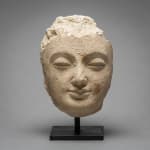Gandharan Stucco Head, 100 CE - 400 CE
height 14 cm
height 5 1/2 in
height 5 1/2 in
AM.0220
Further images
The ancient civilization of Gandhara was located in the region encompassing modern northeastern Afghanistan and northwestern Pakistan. Situated at a confluence of trading paths along the Silk Route, the area...
The ancient civilization of Gandhara was located in the region encompassing modern northeastern Afghanistan and northwestern Pakistan. Situated at a confluence of trading paths along the Silk Route, the area was flooded in diverse cultural influences ranging from Greece to China. Gandhara flourished under the Kushan Dynasty and their great king, Kanishka, who is traditionally given credit for spreading the philosophies of Buddhism throughout central Asia and into China. This period is viewed as the most important era in the history of Buddhism. After the conquests of Alexander the Great, the creation of Greco-Bactrian kingdoms, and the general Hellenization of the subcontinent, Western aesthetics became prominent. Greek influence began permeating into Gandhara. Soon sculptors based the images of the Buddha on Greco-Roman models, depicting Him as a stocky and youthful Apollo, complete with stretched earlobes and loose monastic robes similar to a Roman toga. The extraordinary artistic creations of Gandhara reveal link between the different worlds of the East and West.
Despite surviving in fragmentary form, this stucco head still impresses us with its calm and dignified expression. The mouth and nose have been carved naturalistically but the eyes are highly stylised. This is typical of Gandharan images of the Buddha which this head most likely represents.
Despite surviving in fragmentary form, this stucco head still impresses us with its calm and dignified expression. The mouth and nose have been carved naturalistically but the eyes are highly stylised. This is typical of Gandharan images of the Buddha which this head most likely represents.







